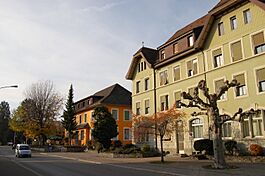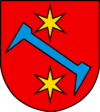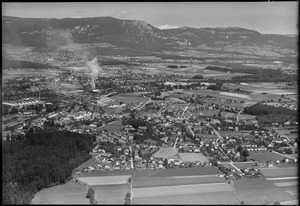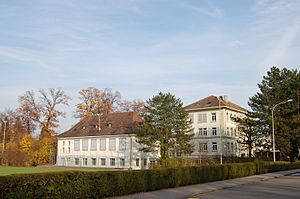Gerlafingen facts for kids
Quick facts for kids
Gerlafingen
|
||
|---|---|---|

Gerlafingen village
|
||
|
||
| Country | Switzerland | |
| Canton | Solothurn | |
| District | Wasseramt | |
| Area | ||
| • Total | 1.86 km2 (0.72 sq mi) | |
| Elevation | 451 m (1,480 ft) | |
| Population
(Dec 2020 )
|
||
| • Total | 5,502 | |
| • Density | 2,958/km2 (7,661/sq mi) | |
| Postal code |
4563
|
|
| Surrounded by | Bätterkinden (BE), Biberist, Derendingen, Kriegstetten, Obergerlafingen, Zielebach (BE) | |
Gerlafingen is a town, also called a municipality, located in the Wasseramt district. It is part of the canton of Solothurn in Switzerland.
Contents
Gerlafingen's Past: A Brief History
Gerlafingen was first mentioned in official records way back in the year 1278. At that time, it was known by a slightly different name: Nidergerolvingen.
Exploring Gerlafingen's Geography
Gerlafingen covers an area of about 1.85 square kilometers (that's about 0.71 square miles). A small part of this land, about 9.7%, is used for farming. Forests cover about 10.3% of the area.
Most of Gerlafingen, about 82.2%, is built up with buildings and roads. This includes homes, businesses, and transportation routes. A tiny part, just 1.1%, is made up of rivers or lakes.
Where is Gerlafingen Located?
This town is found in the Wasseramt district. It sits on the eastern side of the Emme river. Gerlafingen is located about 5 kilometers (or 3 miles) south of the city of Solothurn.
Understanding Gerlafingen's Coat of Arms
A coat of arms is like a special symbol or emblem for a town or family. Gerlafingen's coat of arms has a red background. On it, you'll see a blue "cramp" shape, which looks a bit like a hook or brace. There are also two golden stars, one above the other.
Who Lives in Gerlafingen? Demographics
Gerlafingen has a population of about 4,900 people. This number can change a little each year. About 39.7% of the people living here are from other countries.
What Languages are Spoken?
Most people in Gerlafingen speak German. This is about 77.1% of the population. The second most common language is Italian, spoken by about 7% of residents. Turkish is the third most common, spoken by about 4.8% of the people.
How Old are the Residents?
The population of Gerlafingen includes people of all ages. About 7.4% are young children (0-6 years old). Teenagers (7-19 years old) make up about 15.9% of the population. Adults between 25 and 44 years old are the largest group, making up about 30% of residents. Older adults (65 and over) make up about 18.3% of the population.
How Many Homes are There?
In Gerlafingen, there are about 1,950 private homes. On average, about 2.3 people live in each home. Many homes, about 33.2%, are lived in by just one person. There are also many families with children and married couples without children.
Gerlafingen's Economy: How People Work
In 2010, the unemployment rate in Gerlafingen was 6.3%. This means that 6.3% of people who wanted to work couldn't find a job at that time.
What Kinds of Jobs are There?
People in Gerlafingen work in different types of jobs:
- Primary Sector: This involves jobs related to nature, like farming. In Gerlafingen, a small number of people work in agriculture.
- Secondary Sector: This includes jobs where people make things, like in factories or construction. Many people in Gerlafingen work in manufacturing (making goods) or construction (building things).
- Tertiary Sector: These are service jobs, like working in shops, restaurants, or offices. Many people work in sales, transportation, hotels, education, or healthcare.
Commuting to Work
Many people who live in Gerlafingen travel to other towns for work. Also, some people from other towns come to Gerlafingen to work. Most people, about 59.6%, use a private car to get to work. About 12.2% use public transportation.
Religion in Gerlafingen
Gerlafingen is home to people with different religious beliefs. About 26.4% of the population are Roman Catholic. Another 32.9% belong to the Swiss Reformed Church. There are also people who are Orthodox Christian, Christian Catholic, or belong to other Christian churches.
Some residents are Islamic (about 16.77%), while smaller numbers are Jewish, Buddhist, or Hindu. About 14.74% of the population do not belong to any church or are agnostic or atheist.
Learning in Gerlafingen: Education
Many adults in Gerlafingen have completed a good level of education. About 33.1% have finished high school, and about 7.8% have gone on to higher education, like a university or a specialized college.
School System in Solothurn
The school system in the Canton of Solothurn offers two years of optional Kindergarten for young children. After that, students attend six years of primary school.
The secondary school program has three required years, followed by three to five years of optional advanced schooling. Students from nearby towns like Obergerlafingen and Recherswil also attend the lower secondary school in Gerlafingen.
See also
 In Spanish: Gerlafingen para niños
In Spanish: Gerlafingen para niños






